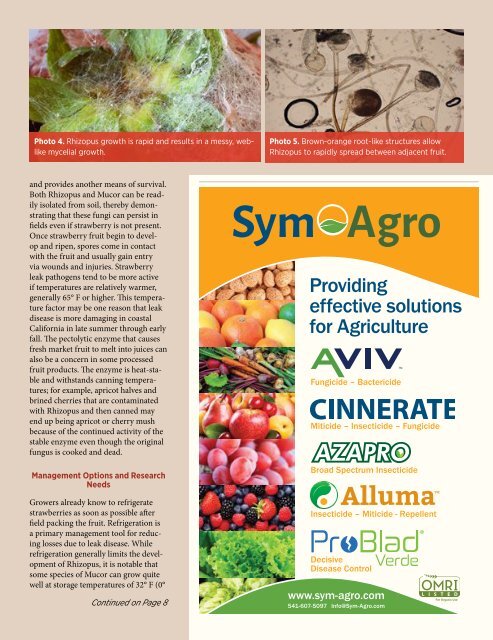PCC Sep Oct 2019
Create successful ePaper yourself
Turn your PDF publications into a flip-book with our unique Google optimized e-Paper software.
Photo 4. Rhizopus growth is rapid and results in a messy, weblike<br />
mycelial growth.<br />
Photo 5. Brown-orange root-like structures allow<br />
Rhizopus to rapidly spread between adjacent fruit.<br />
and provides another means of survival.<br />
Both Rhizopus and Mucor can be readily<br />
isolated from soil, thereby demonstrating<br />
that these fungi can persist in<br />
fields even if strawberry is not present.<br />
Once strawberry fruit begin to develop<br />
and ripen, spores come in contact<br />
with the fruit and usually gain entry<br />
via wounds and injuries. Strawberry<br />
leak pathogens tend to be more active<br />
if temperatures are relatively warmer,<br />
generally 65° F or higher. This temperature<br />
factor may be one reason that leak<br />
disease is more damaging in coastal<br />
California in late summer through early<br />
fall. The pectolytic enzyme that causes<br />
fresh market fruit to melt into juices can<br />
also be a concern in some processed<br />
fruit products. The enzyme is heat-stable<br />
and withstands canning temperatures;<br />
for example, apricot halves and<br />
brined cherries that are contaminated<br />
with Rhizopus and then canned may<br />
end up being apricot or cherry mush<br />
because of the continued activity of the<br />
stable enzyme even though the original<br />
fungus is cooked and dead.<br />
Management Options and Research<br />
Needs<br />
Providing<br />
effective solutions<br />
for Agriculture<br />
Fungicide – Bactericide<br />
Miticide – Insecticide – Fungicide<br />
Broad Spectrum Insecticide<br />
Growers already know to refrigerate<br />
strawberries as soon as possible after<br />
field packing the fruit. Refrigeration is<br />
a primary management tool for reducing<br />
losses due to leak disease. While<br />
refrigeration generally limits the development<br />
of Rhizopus, it is notable that<br />
some species of Mucor can grow quite<br />
well at storage temperatures of 32° F (0°<br />
Continued on Page 8<br />
www.sym-agro.com<br />
541-607-5097 Info@Sym-Agro.com<br />
<strong>Sep</strong>tember /<strong>Oct</strong>ober <strong>2019</strong><br />
Insecticide – Miticide - Repellent<br />
Decisive<br />
Disease Control<br />
www.progressivecrop.com<br />
7


















